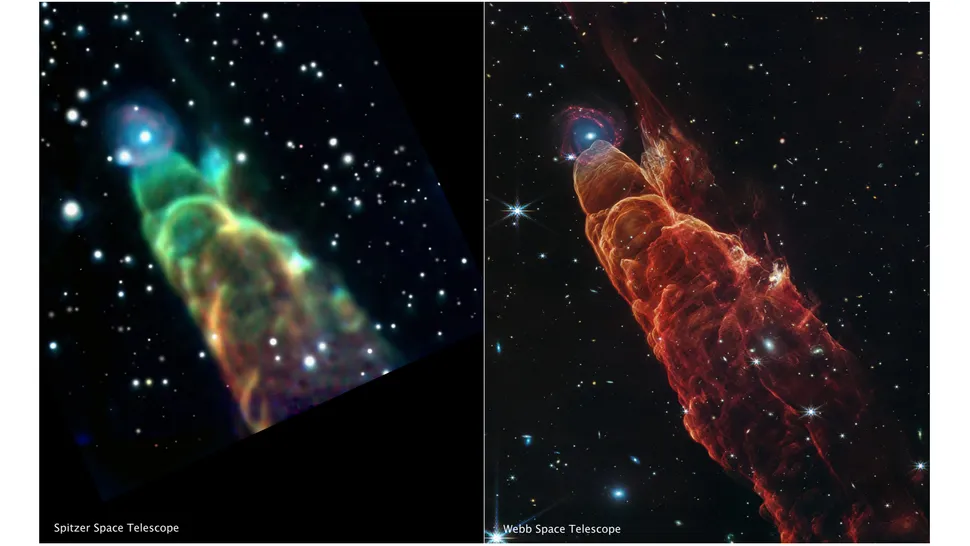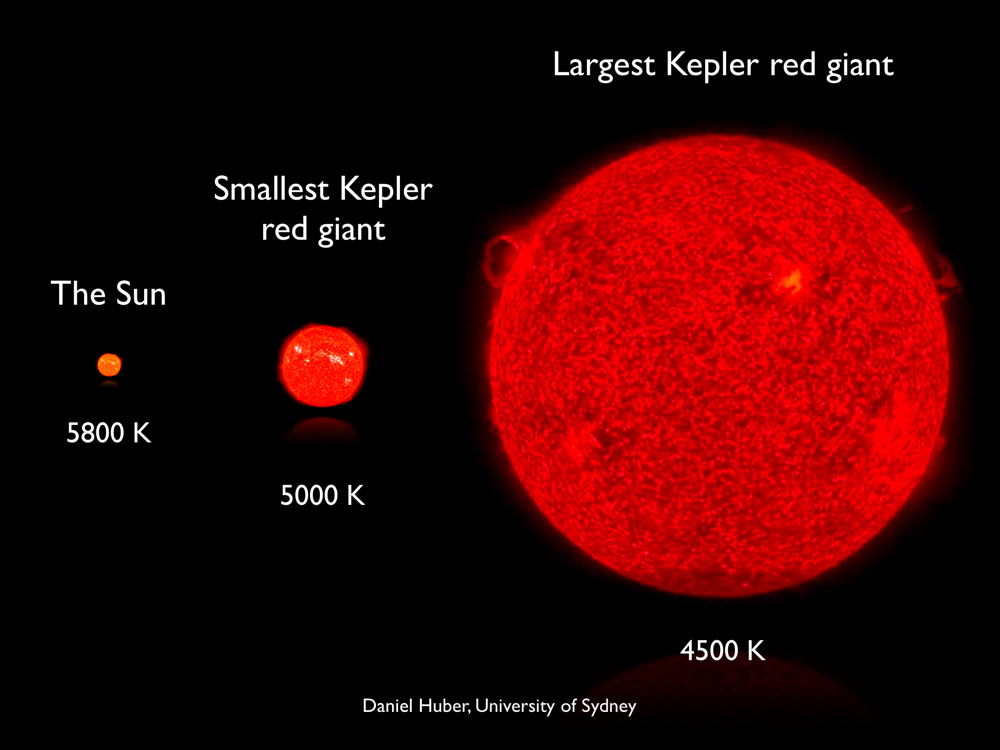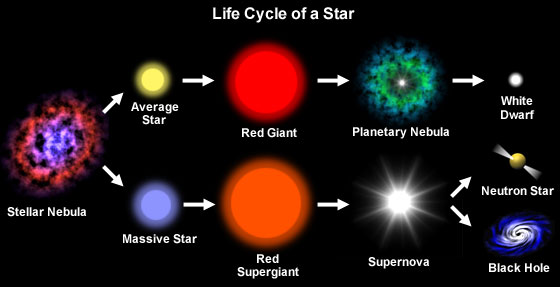
Posted on 03/24/2025 8:00:57 PM PDT by Red Badger

NASA’s James Webb Space Telescope observed Herbig-Haro 49/50, an outflow from a nearby still-forming star, in high-resolution near- and mid-infrared light. The young star is off to the lower left corner of the Webb image. Intricate features of the outflow, represented in reddish-orange color, provide detailed clues about how young stars form and how their jet activity affects the environment around them. A chance alignment in this direction of the sky provides a beautiful juxtaposition of this nearby Herbig-Haro object (located within our Milky Way) with a face-on spiral galaxy in the distant background. Image released on March 24, 2025. (Image credit: NASA, ESA, CSA, STScI)
================================================================================
A cosmic coincidence has led to one of the most amazing images ever captured by NASA's James Webb Space Telescope (JWST).
The dramatic outflow from a newborn star, known as Herbig-Haro 49/50 (HH 49/50), just so happened to align perfectly with a distant spiral galaxy, creating this mesmerizing celestial scene.
Herbig-Haro objects are glowing clouds of gas and dust shaped by newborn stars or protostars. They form when jets of charged particles, ejected from young stars at immense speeds, slam into surrounding material, creating brilliant, ever-changing patterns in the sky.

This side-by-side comparison shows a Spitzer Space Telescope image of HH 49/50 (left) versus a Webb image of the same object (right) using the NIRCam and MIRI instruments. The Webb image shows intricate details of the heated gas and dust as the protostellar jet slams into the material. Webb also resolves the "fuzzy" object located at the tip of the outflow into a distant spiral galaxy. (Image credit: NASA, ESA, CSA, STScI, NASA-JPL, SSC)
==============================================================================
Nestled within the Chamaeleon I Cloud complex — one of the closest stellar nurseries to Earth — Herbig-Haro 49/50 offers a glimpse into the chaotic beauty of star formation. This vast cloud of gas and dust is teeming with newborn, sun-like stars, likely resembling the environment that produced our own solar system.
Related: James Webb Space Telescope (JWST) — A complete guide:
https://www.space.com/21925-james-webb-space-telescope-jwst.html
First observed in 2006 by NASA's now-retired Spitzer Space Telescope, past observations revealed that the HH 49/50 outflow is racing away from Earth at astonishing speeds of 100 to 300 kilometers per second (60 to 190 miles per second).
Scientists have suspected that the source of the Herbig-Haro 49/50 outflow is a protostar known as Cederblad 110 IRS4 (CED 110 IRS4), which is located roughly 1.5 light-years away from the object.
By cosmic standards, CED 110 IRS4 is quite young — just tens of thousands to a million years old — and is still growing, pulling in material from its surrounding disk. As part of this process, some of the gas gets funneled along the protostar's magnetic field lines and shot out as high-speed jets. These jets slam into surrounding clouds of gas and dust, creating Herbig-Haro objects, which are glowing shock waves marking where the outflow collides with its surroundings.
HH 49/50 is one of these impact sites. It was nicknamed the "Cosmic Tornado" due to its dramatic, swirling shape. Spitzer's images weren't clear enough to discern the fuzzy object located at its tip — but JWST's are.
Using Webb's NIRCam and Mid-Infrared Instrument (MIRI), astronomers have captured glowing hydrogen and carbon monoxide molecules (shown in orange and red in the image), which are being heated and energized by the powerful jets from the nearby newborn star. These molecules, along with energized grains of dust, illuminate the intricate and dynamic processes shaping the star's surroundings.
Webb's detailed images of HH 49/50 reveal arcs of glowing gas that helped astronomers trace the path of the jet back to its source — CED 110IRS4. However, not all arcs align perfectly with the same direction.
One particularly odd feature — an outcrop near the top of the main outflow — doesn't seem to fit. Scientists think it might be a second, unrelated outflow that happens to overlap in the image. Another possibility is that the main outflow is breaking apart, creating this strange shape. The irregular patterns may also be caused by the slow, wobbly motion of the protostar's jet over time, a phenomenon known as precession.
"Webb has captured these two unassociated objects in a lucky alignment," the Webb team wrote in a statement today (March 24), when the new imagery was released. "Over thousands of years, the edge of HH 49/50 will move outwards and eventually appear to cover up the distant galaxy."
WEBB PING!................
That is cool! The 2 photos side by side, the first one looks like looking into the sky with cataracts- you can see the lights, but they are bloomed out and have halos around d them, and of course aren’t c,ear and sharp. The web telescope is a beast
You prolly know this, but incase some don’t, when loo,ing at the sky and stars, the reddish and oranges stars are apparently new stars, while the blue are older ones- has to do with the heat I guess, new stars generating heat while o,der stars have lost the heat as they stadr to die out. I’m not real up,on the issue, but heard that back awhile.
Wow!
But it should be remembered the Spitzer Space Telescope was the first telescope in history to detect a planet outside of our own solar system. That was a really big achievement.
True- it is still a great telescope- no doubt- much better than my pair of binoculars lol. (I acfually have a camera lens that is more powerful, about 800mm, but still just a pup compared to the telescopes 😆
I didn’t know that.
D9nt quote me on it, but it’s what I heard once
Doh! Ok I got it backerds, per usual- blue are hottest, red coldest- this site exp,ains it
https://sciencenotes.org/the-colors-of-the-stars-from-hottest-to-coldest/
A giant space chem trail... /S
Our Sun, when it runs out of core hydrogen to fuse, it will become a Red Giant, expand suddenly and engulf EVERYTHING within the Orbit of Mars, maybe even Mars itself.
Betelgeuse, Orion’s shoulder, is one such star.
From Google AI:
A red giant is a luminous, late-stage star of low or intermediate mass that has exhausted its core hydrogen fuel and expanded significantly, becoming larger and cooler than it was on the main sequence.
Here’s a more detailed explanation:
Stellar Evolution:
Red giants are a phase in the life cycle of stars with masses between roughly 0.4 and 12 times the
mass of our Sun (or 8 times for low-metallicity stars).
Core Exhaustion:
When a star runs out of hydrogen fuel in its core, it begins to fuse hydrogen in a shell
surrounding the core.
Expansion:
This shell burning causes the star to expand dramatically, becoming a red giant, which can be 100
to 1,000 times wider than our Sun.
Cooler Surface:
While the core becomes hotter, the outer layers cool and become redder, hence the name “red giant”.
Future of the Sun:
In about 6 billion years, our Sun will also become a red giant, expanding and potentially engulfing
the inner planets, including Earth.
Red Giant Branch:
The evolutionary path a star takes after becoming a red giant is called the red-giant branch.
Red Supergiants:
More massive stars (10 to 40 times the mass of the Sun) can become even larger, cooler, and
brighter red supergiants.


It looks like that planet eater thingie from Star Trek TOS.
The one that ate Will Decker’s dad...
😱
How come we can get brilliant pictures like this of an object millions of miles away, but when some thug robs a convenience store, the best we can get is a blurry photo of the guy from a security camera ten feet away?
Blue MOOOOOOOOOOOOOOOON! I saw you standing aloooone!.........
Convenience store operators are notoriously cheap and the cameras are at least 20 years old.............
Disclaimer: Opinions posted on Free Republic are those of the individual posters and do not necessarily represent the opinion of Free Republic or its management. All materials posted herein are protected by copyright law and the exemption for fair use of copyrighted works.